Vehicle equipped with steel wheels
Tighten the wheel nuts (tapered nuts) until the tapered parts of the wheel nuts make light contact with the seats of the wheel holes and the wheel is not loose.
With a spare wheel, tighten the wheel nuts in the same way.
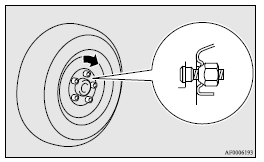
Vehicle equipped with aluminium wheels
Tighten the wheel nuts (flange nuts) until the flanges of the wheel nuts touch the wheel and the wheel is not loose.
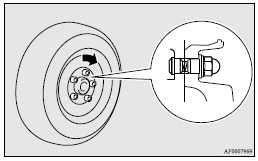
![]() Note
Note
► Flange nuts can be temporarily used on the steel spare wheel as shown in the illustration, but return to the original wheel and tyre as soon as possible.
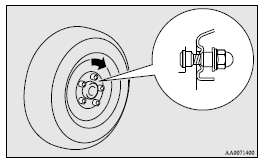
► If all 4 aluminium wheels are changed to steel wheels, e.g. when fitting winter tyres, use tapered nuts.
![]() Caution
Caution
► Never apply oil to either the wheel bolts or the nuts, or they will tighten too much.
8. Lower the vehicle slowly by rotating the wheel nut wrench anticlockwise until the tyre touches the ground.
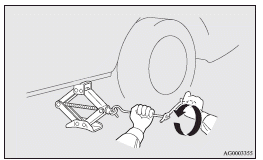
9. Tighten the nuts in the order shown in the illustration until each nut has been tightened to the torque listed here.
Tightening torque 88 to 108 Nm (Achieved by applying a force of 350 to 420 N at the end of the wheel nut wrench supplied with the vehicle.)
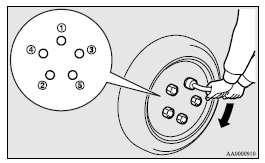
![]() Caution
Caution
► Never use your foot or a pipe extension for extra force in the wheel nut wrench.
If you do so, you will tighten the nut too much.
10. Lower the jack all the way and remove it.
11. Check your tyre inflation pressure at the next gasstation. The correct pressures
are shown on the door label. See the illustration.
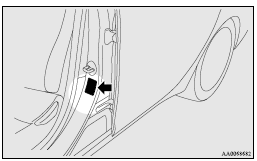
![]() Caution
Caution
► The tyre pressure should be periodically checked and maintained at the specified
pressure while the tyre is stowed.
► The compact spare tyre is to be used only temporarily when the standard tyre is
damaged. Repair the damaged tyre as soon as possible and use it to replace the compact
spare tyre.
► After changing the tyre and driving the vehicle about 1.000 km (620 miles), retighten
the wheel nuts to make sure that they have not come loose.
► If the steering wheel vibrates when driving after changing the tyre, we recommend
you to have the tyres checked for balance.
► Do not mix one type of tyre with another or use a different size from the one
listed.
This would cause early wear and poor handling.
See also:
Wiper blades
Use a soft cloth and glass cleaner to remove grease, dead insects, etc., from
the wiper blades. Replace the wiper blades when they no longer wipe properly. ...
Operation from inside the vehicle
The boot lid (or tailgate) can be locked or unlocked by using the central door
lock switch, regardless of the position of the ignition key.
1- Unlock 2- Lock
If the boot lid (or tailgate) is loc ...
Installing a child restraint system to a3-point type seat belt (with
emergency locking
mechanism)
3-point type seat belt location
The child restraint system can be fitted by using the 3-point type seat belt
at the below illustrated seating position.
Installation:
1. Fasten the seat belt to ...
